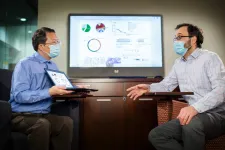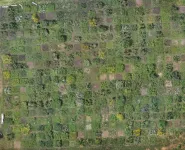(Press-News.org) Every year around 20 Australian children die from the incurable brain tumour, Diffuse Intrinsic Pontine Glioma (DIPG). The average age of diagnosis for DIPG is just seven years. There are no effective treatments, and almost all children die from the disease, usually within one year of diagnosis.
A paper published today 12 Feb 2021 in the prestigious journal, Nature Communications, reveals a potential revolutionary drug combination that - in animal studies and in world first 3D models of the tumour - is "spectacularly effective in eradicating the cancer cells," according to lead researcher and paediatric oncologist Associate Professor David Ziegler, from the Children's Cancer Institute and Sydney Children's Hospital.
In pre-clinical testing in mouse models, the researchers found that the promising drug combination led to survival in two thirds of the mice and that the drug combination completely halted growth of these highly aggressive tumours in these mice.
Importantly, the drug therapy, which is currently in early trials in adult cancer, is the most effective treatment ever tested in laboratory models of this incurable childhood cancer. The treatment is a combination of two drugs: difluoromethylornithine (DFMO), an established drug, and AMXT 1501, an investigational agent being developed by Aminex Therapeutics.
The DFMO is increasingly getting attention as a treatment for difficult-to-control cancers like neuroblastoma, another aggressive childhood cancer, and colorectal cancer in adults. DFMO works by targeting the polyamine pathway - an important mechanism that allows tumour cells to grow.
Associate Professor Ziegler has shown for the first time that the polyamine pathway is critical to the growth of DIPG cells. Ziegler and his team developed Australia's first research program into DIPG by using tumour cells donated by the parents of children who have passed away from the disease. From these, they created the first laboratory models of the tumour in order to test new drugs. These models have been used to show that DIPG can bypass the activity of DFMO by pumping polyamines into the cancer, essentially allowing the tumour to continue growing despite treatment with DFMO. They have now made the breakthrough discovery that treatment with a new developmental drug, AMXT 1501, potently blocks the transport of polyamines into the DIPG cancer cell.
Treatment with AMXT 1501 was found to re-sensitize the DIPG cells to DFMO leading to what Associate Professor Ziegler said, "was a spectacular response in animal models, with a significantly increased survival and minimal toxicity (side effects)".
Associate Professor Ziegler said that clinical trials of the drug combination in DIPG are planned to begin this year in children in a global study led by the Children's Cancer Institute and the Kid's Cancer Centre at Sydney Children's Hospital.
The Australian DIPG Tumour Database was started by the Children's Cancer Institute in 2011.. Australia's first DIPG tumour data base has allowed Associate Professor Ziegler and colleagues to make great inroads into solving this disease. "Since establishing the tumour bank we have been able to grow this very aggressive cancer in our laboratories to allow us to screen hundreds of drugs to find those that are effective at killing the cancer cells. Its due to this capacity that we have been able to discover what we hope will be the first effective treatment for DIPG," he said.
Rachael Gjorgjijoska was the first parent to agree to donate DIPG tumour tissue following the death of her daughter Liliana at just 4 years old, 15 months after her diagnosis. Rachael comments "We made the difficult decision to donate Liliana's tumour because we wanted to make a difference, there were no treatments to save Liliana from this devastating disease, but if her cancer cells help advance research so there be new treatments for children in the future, this will be a lasting memory of our little girl."
Dr. Mark R. Burns, the Founder, President and Chief Scientific Officer at Aminex Therapeutics, and inventor of AMXT 1501 said "the dramatic results against this devastating disease demonstrated by Dr. Ziegler and his team adds greater fire to our motivation to see these findings duplicated against human cancers. We share hope that this treatment will make a difference in the lives of those with DIPG and other aggressive cancers."
INFORMATION:
This work was supported by grants from the National Health and Medical Research Council, Cancer Institute NSW, the DIPG Collaborative, the Cure Starts Now, Cure Brain Cancer Foundation, Levi's project, Benny Wills Brain Tumour Research fund, Tour de Cure, Isabella and Marcus Foundation's Gemma Howell Scholarship and drug supply from Aminex Therapeutics, Inc.
About Children's Cancer Institute
Originally founded by two fathers of children with cancer in 1976, Children's Cancer Institute is the only independent medical research institute in Australia wholly dedicated to research into the causes, prevention and cure of childhood cancer. Forty years on, our vision is to save the lives of all children with cancer and improve their long-term health, through research. The Institute has grown to now employ over 300 researchers, operational staff and students, and has established a national and international reputation for scientific excellence. Our focus is on translational research, and we have an integrated team of laboratory researchers and clinician scientists who work together in partnership to discover new treatments which can be progressed from the lab bench to the beds of children on wards in our hospitals as quickly as possible. These new treatments are specifically targeting childhood cancers, so we can develop safer and more effective drugs and drug combinations that will minimise side-effects and ultimately give children with cancer the best chance of a cure with the highest possible quality of life. More at http://www.ccia.org.au
Children's Cancer Institute contact:
Tania Ewing - Phone: 0408 378 422, taniaewing@taniaewing.com
About Aminex Therapeutics
Aminex Therapeutics, Inc. is a clinical-stage biotechnology company focused on the development of a novel small molecule combination therapy for the treatment of broad range of cancer indications. Aminex has advanced AMXT 1501 + DFMO through target discovery, patenting, pre-clinical research and now into clinical development for the potential benefit of cancer patients. For more information, please visit http://www.aminextx.com
Aminex contact:
Julie Rathbun - Rathbun Communications, Phone: 206-769-9219, Julie@rathbuncomm.com
Children treated for cancer with approaches such as chemotherapy can develop therapy-related myeloid neoplasms (a second type of cancer) with a dismal prognosis. Scientists at St. Jude Children's Research Hospital have characterized the genomic abnormalities of 84 such myeloid neoplasms, with potential implications for early interventions to stop the disease. A paper detailing the work was published today in Nature Communications.
The somatic (cancer) and germline (inherited) genomic alterations that drive therapy-related myeloid neoplasms in children have not been comprehensively ...
(Friday, February 12, 2021 - Toronto) -- Inhibiting a key enzyme that controls a large network of proteins important in cell division and growth paves the way for a new class of drugs that could stop glioblastoma, a deadly brain cancer, from growing.
Researchers at Princess Margaret Cancer Centre, the Hospital for Sick Children (SickKids) and University of Toronto, showed that chemically inhibiting the enzyme PRMT5 can suppress the growth of glioblastoma cells.
The inhibition of PRMT5 led to cell senescence, similar to what happens to cells during aging when cells lose the ability to divide and grow. Cellular senescence can also be a powerful tumour suppression mechanism, stopping ...
Space: the final frontier. What's stopping us from exploring it? Well, lots of things, but one of the major issues is space radiation, and the effects it can have on astronaut health during long voyages. A new review in the open-access journal END ...
Research over the last 20 years has shown that atherosclerosis is a chronic inflammatory condition of the arterial blood vessel wall. Soluble mediators such as cytokines and chemokines are pivotal players in this disease, promoting vascular inflammation. However, the development of anti-inflammatory therapeutics directed against such mediators that could prevent atherosclerosis has proven difficult, despite promising clinical studies in the recent past.
Previous anti-inflammatory therapeutic strategies to prevent atherosclerosis, heart attacks, strokes, rheumatoid arthritis and other inflammatory diseases have mainly been based ...
Remote sensing technology has become a vital tool for scientists over the past several decades for monitoring changes in land use, ice cover, and vegetation across the globe. Satellite imagery, however, is typically available at only coarse resolutions, allowing only for the analysis of broad trends over large areas. Remote-controlled drones are an increasingly affordable alternative for researchers working at finer scales in ecology and agriculture, but the laser-based technology used to estimate plant productivity and biomass, such as light detection and ranging (LiDAR), remain prohibitively expensive.
In research presented in a recently published issue of Applications in Plant Sciences, researchers ...
New research has shown that results of blood tests routinely performed by GPs everywhere contain a hidden fingerprint that can identify people silently developing potentially fatal liver cirrhosis.
The researchers have developed an algorithm to detect this fingerprint that could be freely installed on any clinical computer, making this a low-cost way for GPs to carry out large scale screening using patient data they already hold.
Liver cirrhosis is the second leading disease causing premature death in working-age people (after heart disease). It develops silently ...
Peer-reviewed / Observational study / People
For the study, published in the journal Diabetes, Obesity and Metabolism, researchers analysed data from the UK Biobank of 500,000 people aged 58 years on average, and found that people with higher than normal blood sugar levels were 42% more likely to experience cognitive decline over an average of four years, and were 54% more likely to develop vascular dementia over an average of eight years (although absolute rates of both cognitive decline and dementia were low).
The associations remained true after other influential factors had been taken into account - including age, deprivation, smoking, BMI and whether or not participants had cardiovascular disease.
People with ...
A team of scientists have measured the relative importance of the different obstacles that carbon dioxide (CO2) encounters in its voyage from the atmosphere to the interior of plant cells, where it is converted into sugars. This research leading method provides much needed information that will help to increase the yield of important food crops such as cowpea, soybean and cassava.
"Our data highlights promising targets to improve the diffusion of CO2 through the leaf with the aim of boosting crop productivity," says lead author Dr Tory Clarke, who works at The Australian National University (ANU), as part of the Realizing Increased Photosynthetic ...
Psychologists at the University of Bath, Cardiff, and London have developed the first ever 'mind-reading questionnaire' to assess how well people understand what others are really thinking.
A new approach to 'mind-reading' has been developed by researchers at the University of Bath, Cardiff, and London to improve how well we understand what others are thinking. And it transpires that women are much better than men at putting themselves in someone else's shoes.
Mind-reading, sometimes referred to in psychology as 'mentalising', is an important ability enabling us to pick-up on subtle behavioural cues that might indicate that someone we are speaking to is thinking ...
A new modelling study published in Anaesthesia (a journal of the Association of Anaesthetists) shows that the UK's coronavirus vaccination program is already reducing daily deaths. However, reductions of hospital and intensive care (ICU) admissions will likely take several weeks longer, with large reductions seen by the end of March and continuing into April.
The study is by Professor Tim Cook (Consultant in Anaesthesia and Intensive Care Medicine, Royal United Hospitals Bath NHS Foundation Trust, Bath, UK, and Honorary Professor, School of Medicine, University of Bristol, UK) and Mr ...



